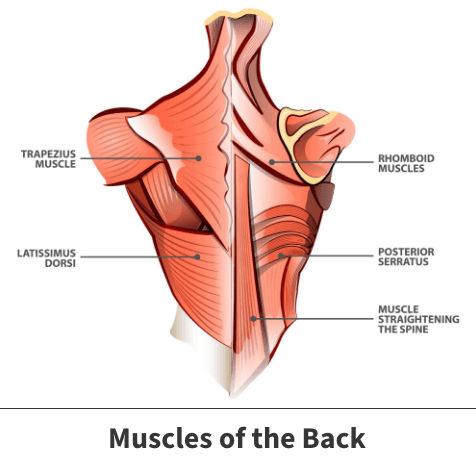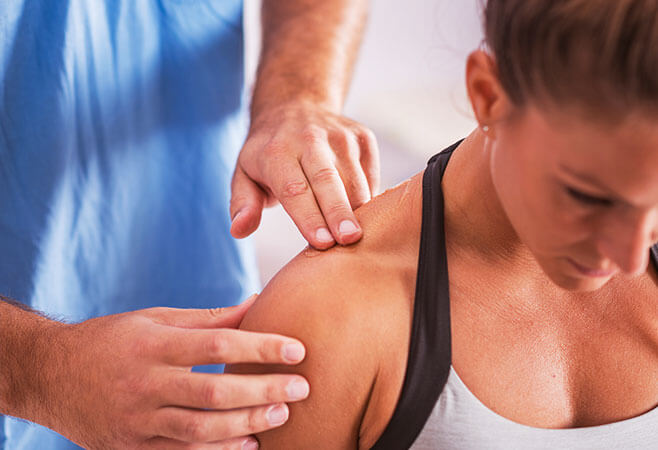Muscle strain of the upper back
Pain in trapezius muscle
The upper back is a complex collection of physical parts responsible for helping stabilize your neck and making sure you can stand straight and walk. One of the more essential parts of this region is the trapezius muscle.
The pressure and force placed on this muscle increase its risk of developing a trapezius strain, the upper back muscle strain.
Anatomy

The trapezius is a large, trapezoid-shaped muscle beginning at your skull’s base and extending to your middle back. This area is so large that it is divided into three parts:
- The upper section – this part of the trapezius is located near your neck’s rear
- The middle section – this central region lies in your shoulders and upper back
- The lower section – this final section extends to your middle back
Without this muscle, you would be unable to move your shoulders or bend your neck.
About
Trapezius strains happen when any part of the muscle becomes injured. Strains vary in severity. Mild strains only involve overstretching of the affected muscle and cause mild symptoms. Muscle tears are often more severe and cause far more noticeable and potentially debilitating issues.
Causes
Many trapezius strains result from chronic overuse of frequent, mild to moderate shoulder motions that cause stress. Other injuries occur following immediate, forceful contact with the upper back, as seen in events like falls and car accidents. Acute injuries can also occur during strenuous athletic activities.
Risk factors
Your risk of sustaining a trapezius strain increases if you are employed in a profession that puts added pressure on your upper back region. Common examples include:
- Construction workers
- Movers
- Firefighters
- Bricklayers
You are at higher risk of straining your upper back if you participate in sports such as:
- Strongman competitions
- Volleyball
- Football
- Basketball
- Mountain climbing
Traumatic events do not always cause acute injuries. Back-stressing actions like lugging heavy groceries, practicing poor posture, driving long distances, or sitting at a desk can bring on problems.
Symptoms
The symptoms you experience can vary depending on the strain’s extent.
Trapezius muscle issues often cause common symptoms, like:
- Pain and stiffness in the upper back, neck, or shoulder regions
- Burning
- Noticeable swelling
- Headaches
- Limited mobility of your neck and shoulders
Symptoms often worsen when you move the injured muscle. In mild cases, the problems may come and go. Muscle tears can lead to consistent discomfort and disability.
Complications
Failure to treat a trapezius strain could result in more severe injury, worsening symptoms, and the need for more aggressive treatment.

Diagnosis
Your physician will closely examine your upper back, neck, and shoulders for any visual signs. You might also be asked to perform specific movements to measure your pain threshold, motion range, and muscle strength.
Using internal imaging devices like X-rays and MRI scans is only necessary if your doctor believes you have a serious trapezius tear. These diagnostic tests can help determine the severity of such injuries.
Treatment
A significant percentage of trapezius strains heal over time on their own without any significant treatment. Fortunately, most injuries do not need surgery.
Nonsurgical treatments
- Home remedies – Mild strains may be relieved by simple home treatment techniques like resting the injured muscle and applying ice or heat to sore or swollen areas. Over-the-counter pain-reducing and inflammation-alleviating medications may help.
- Exercises – Symptoms resulting from more moderate occurrences might improve through the performance of specific exercises. For example, specially designed shoulder and neck stretches may speed up the healing process and strengthen the muscle.
Surgical treatments
Usually, only the most severe trapezius tears will need surgery. Surgery is often unnecessary unless the injury has caused damage to other physical components like neighboring nerves or bones.
Recovery
You should expect to recover fully. Mild injuries might reach this stage in only a few weeks. Severe or complicated strains or tears might take several months to heal completely.
Prevention
Stretching frequently is paramount to preventing or reducing your chances of developing muscle strains. Maintaining proper posture when sitting, standing, and walking is also advised.
Videos
Related specialties
- AC Joint Injuries
- Atraumatic Shoulder Instability
- Bankart Repair
- Bicep Tenodesis
- Broken Collarbone
- Bursitis of the Shoulder (Subacromial Bursitis)
- Calcific Tendinitis of the Shoulder
- Clavicle Fractures
- Dislocated Shoulder
- Fractures of the Shoulder Blade (Scapula)
- Glenoid Labrum Tear
- Impingement Syndrome of the Shoulder
- Little League Shoulder
- Reverse Total Shoulder Replacement
- Rheumatoid Arthritis (RA) of the Shoulder
- Rotator Cuff Tears
- Shoulder Arthritis
- Shoulder Arthroscopy
- Shoulder Injury: Pain in the Overhead Athlete
- Shoulder Replacement
- Shoulder Separations
- Shoulder Socket Fracture (Glenoid Fracture)
- SLAP Tears & Repairs
- Subacromial Decompression
- Traumatic Shoulder Instability
